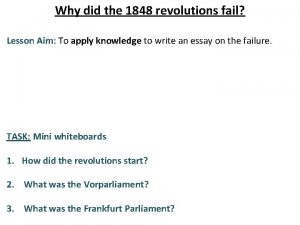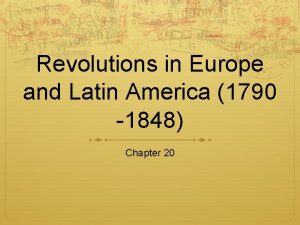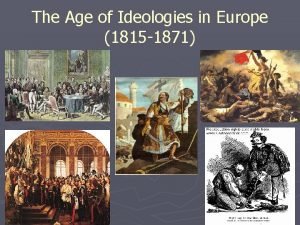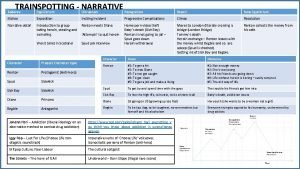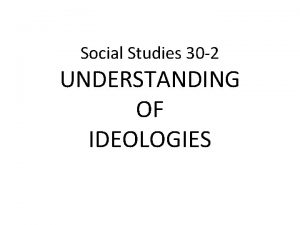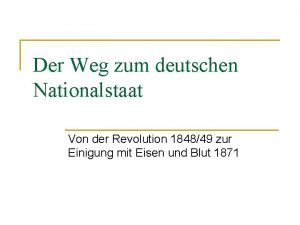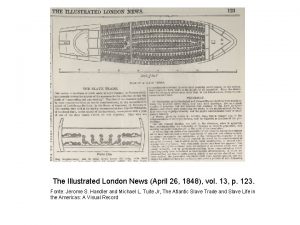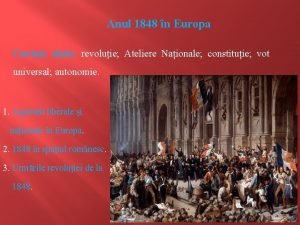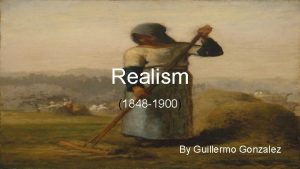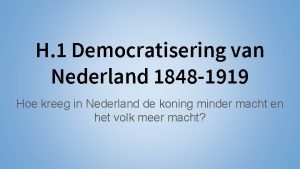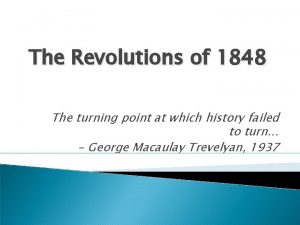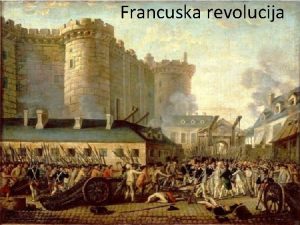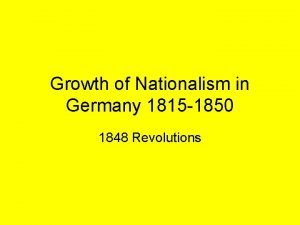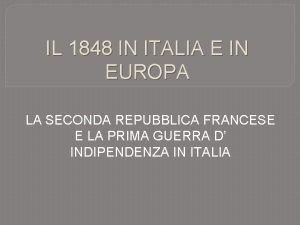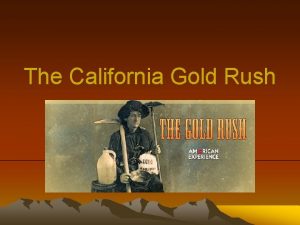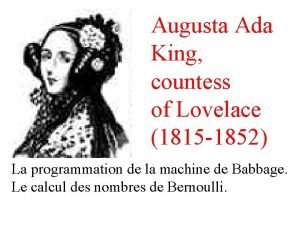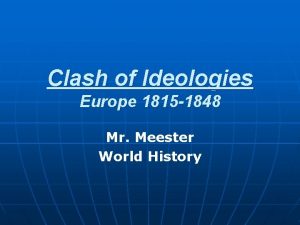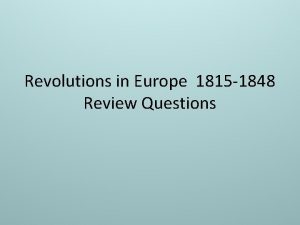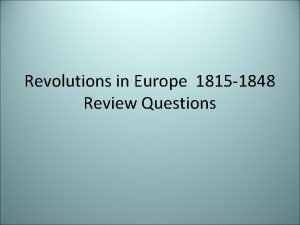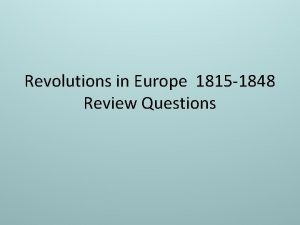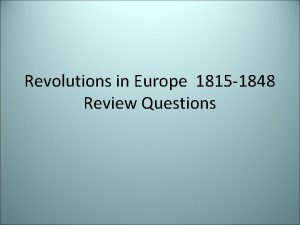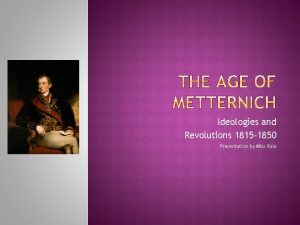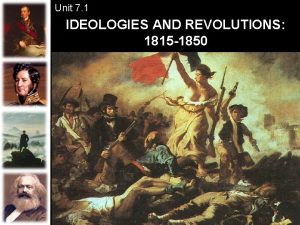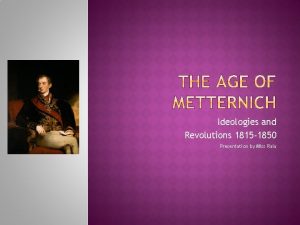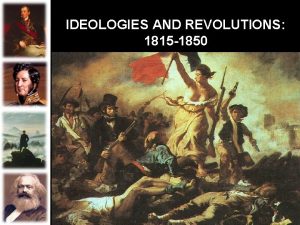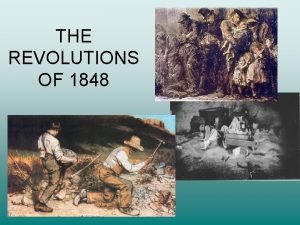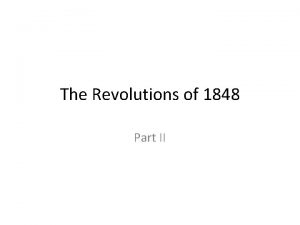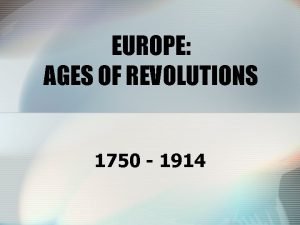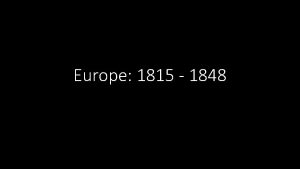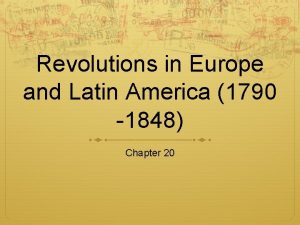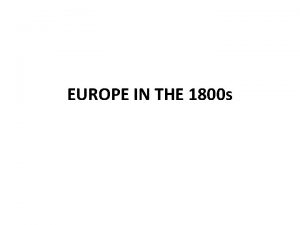Revolutions of 1848 Ideologies of Change Europe 1815









































- Slides: 41

Revolutions of 1848 Ideologies of Change: Europe 1815 -1914

Europe: c. 1814 Congress of Vienna: -Late 18 th c. French Revolution (social, economic, political) - under Napoleon: France led Europe into War - defeated by ‘allies’ -- Russia, Prussia, Austria, Britain, all ‘conservative monarchies’ -France accepted return of Bourbon dynasty 1814 -15: Congress was agreement to ‘balance’ power and control for outbreak of ‘Radical’ or ‘Revolutionary’ ideas

Four Allies Meet in Vienna

National European Boundaries: set by Congress of Vienna 1815

“Balancing Dance” : 1815

Europe: 1815 -1848 Attempt to limit ‘radicalism’ provoked new responses: - Liberalism - Socialism - Nationalism All rooted in ‘New Middle Classes’

Europe: 1815 -1848 Social-Economic ‘structure’ of Europe c. 1815: -‘Conservatives’ supported landed, traditional aristocracies, Monarchies whose right to wealth and power was protected by birth - 19 th C. : compatible with limited ‘parliamentary representation’ -- limited to their elite class - exclusively male

Europe: 1815 -1848 Social-Economic ‘structure’ of Europe c. 1815: -Newly emerging ‘Middle Classes’: role of Industrialization -Many identified with ‘conservative elite’: aimed to climb socio/economic ladder -Others sought new identity: aimed for more representation ‘Radical’ or ‘Revolutionary’ did not necessarily mean overthrowing monarchies

Europe: 1815 -1848 • The Middle Class: a new phenomenon - Trading Families challenged 'Traditional Wealth’ since 16 th. C. - Commerce (especially in slaves, with the Americas) created wealth that demanded political attention - 19 th century change: new wealth generated by Industrialization (factory owners, managers etc) Political alignments reflected different ‘sources’ of wealth

Europe: 1815 -1848 • Liberalism: - Acknowledged existing power structure to extent it permitted limited (political) representation - Wanted to ‘expand’ limits: with respect to equality before law, individual rights - Wanted to ‘retain’ limits: property pre-requisites - By mid-century: influence of ‘laissez-faire’ economics causing divisions

Europe: 1815 -1848 • Socialism - French middle class appalled by complete rejection of Revolution’s values - Seeming turn to ‘laissez-faire’ economics by some factions middle class, exacerbated position - Saw poor getting poorer: economy industrializing, urban - argued need for Government intervention, goal of ‘equalizing’ access to wealth [debate Textbook p. 748]

Factory Towns

Manchester (c. 1865)

Abandoned Children: Paris A huge problem: the children Of the poor – abhorred and feared by the Wealthy Such a serious problem that state-run hospices were Established in 19 th to care For abandoned children

Couple Leaving Child 1862 -3 From Le Boulevard. Gustave Doré.

Europe: 1815 -1848 • Socialism: - Intellectual centre France until 1840 s - Shift occurred with Karl Marx and Friedrich Engels - German Intellectuals drawing heavily on French ‘ideas’; influenced by Marx’s visit to Industrialized England (Manchester) in 1830 s (Marx, Engels discussed Textbook p. 708)

Communist Manifesto: Russian publication

Europe: 1815 -1848 • The Communist Manifesto 1848 - Based on French Socialism but disagreed that the Middle Class (and governments elected by it) could/would ever ‘care for’ the Poor - Argued bourgeoisie (new middle class) would rise up against aristocrats; proletariat (new working class) would rise up against bourgeoisie - Capitalism would bring about its own downfall. And Soon!

Europe: 1815 -1848 • The Communist Manifesto 1848 - Socialist agenda grew from economy and society rooted in agriculture, in early phases of ‘industrialization’ (late 1700 s-early 1820 s) - Communist agenda grew from economies and societies rooted in late industrialization (England Germany, 1830 s) and workers: proletariet Recognized as major ideology: first to give agency to ‘workers’ -- notably not to ‘poor’ in general

Europe: 1815 -1848 • Nationalism: ideology consistent with other new political beliefs - ‘cultural sharing’ of language, history defines a ‘people’, a ‘nation’: rights to territory, autonomy, power - Unrealistic (in European context), ‘romanticized’ but still became powerful political force (see ‘Views’ Textbook p. 721) - Emotionally appealing: used art, music, ritual, rhetoric Emotions can be channelled easily, not always for ‘good’

Europe: 1815 -1848 • All ideologies translated powerfully into 20 th C. • Nationalism embraced by conservatives, liberals, socialists in different contexts (e. g. Ottoman Empire, Russian Empire, Latin America) • Antithetical only to Marxists: class-consciousness cross cuts national (and all other) forms of consciousness • Nationalism tied into ‘colonialism’: expansion of empire became part of nationalist platform later part of 19 th C.

Reform & Revolution • Great Britain - Centre of Europe’s Industrial Revolution (from 18 th C. ) produced large middle class, even larger working class - Middle class demanding ‘liberal’ reforms: greater representation, more legal rights – ‘buy in’ to political, social structure - Working class protesting their lack of rights: wanted to vote, better working conditions – became strong voice in 1840 s

Reform & Revolution • Great Britain - Conservative government responded with ‘Ten Hours Act’ limiting workday for women, children –provided some relief for huge proportion work force - Dampened workers’ radicalism - Bought support of some middle class But workers issues grew in political importance – strikes, rise of unions – by latter part century

Women and Children: Majority of Workers in Textile Industries

Factory Work and Women

Reform & Revolution • Great Britain - Real problem: ‘The Irish’ - Significance: showed weakness of ‘laissez-faire’ economy - Great Famine 1840 s-1851: no government assistance - Over million and a half died, over a million fled (other parts of Europe but mostly, America) Origins domestic political conflict dominating 20 th C. Britain

Reform & Revolution • France - Example of ‘liberalism’: new constitution 1814 protected many rights gained in former revolution by middle class and peasantry (property key factor) - Voting restricted to very small minority of them - 1824 -30: conservative factions drew on nationalism to gain support - Colonial conquest Algiers (North Africa) – “New Imperialism”

Reform & Revolution • France - success: government drew on ‘nationalist pride’ to repute 1814 Constitution immediately afterwards (1830) - Sparked liberal protest across Europe - Louis Phillipe took throne: reinstated Constitution but kept control of parliament; only small enfranshisement - 1840 s: economy suffering – agricultural disasters, slow industrial growth, decline living conditions

Reform & Revolution • France - Political protests increased (as in much of Europe) - 1848: protest became revolution in Paris - Several ‘socio-economic’ groups (middle classes, workers, peasants) including liberals, socialists-- united against ‘bourgeois monarchy’ - Paris centre of violent conflict – ‘up with the barricades’

Paris 1848

Reform & Revolution • France - King again abdicated: new monarchy initially conciliatory - Right to vote extended to all male adults - Workshops established for the poor - Slavery abolished in Colonies - Political coalition that fought for ‘revolution’ fell apart – too many differences, especially between ‘others’ and socialists - In spite of expansion of voter-base, election of 1848 overwhelmingly put conservatives into assembly

“We Managed to get rid of Louis Phillipe – why not this Claptrap as Well!” ‘Claptrap’ is Military – comment on association of hated military with Monarchy

Reform & Revolution • France - ‘clash of ideologies’ became ‘clash of arms’: 3 days in June, more than 10, 000 killed or wounded - Government had army and peasants on its side: ‘won’ - Widespread fear of more violence cross-cut socioeconomic, political groups Louis Napoleon elected ‘landslide’ victory: dismissed assembly, year later recognized as ‘hereditary Emperor’

Reform & Revolution • France - Experience shows conflicts and contradictions of 19 th C. political movements, strength of new ideologies - In real terms, weakened France vis-à-vis ‘neighbours’: soon allowed for significant changes in so-called ‘balance’ created by Congress Vienna (i. e. disastrous War with Prussia, 1870) - Exacerbated growth ‘nationalism’ as expressed through Colonialism; reflected in ‘Scramble for Africa’

Reform & Revolution • Central Europe - France reflected on larger canvas: shared economic crises mid-1840 s, political protests widespread - Demands were of ‘liberal’ nature: establishment of Constitution (lacking in Austrian Empire, German principalities, Prussia etc. ), representative government, civil ‘rights’, equality in law… - Monarchies/elites resisted: political coalitions (like France) formed to increase pressure of demands – workers, students, middle classes (including peasants)

Reform & Revolution • Central Europe - But (also as in France): coalitions weak - workers of less significance (regions less industrialized): relatively easy to ‘buy-off’ middle-classes among whom property-owning peasants predominant - Austrian Empire: in Hungary, monarch appeased peasants by abolishing serfdom

“Vengeance of Serfs” Engraving by Charles Michel Geoffroy, 1845

Proclamation of Count Josip Jelacic Abolishing Serfdom in the Kingdom of Croatia [April 25, 1848]

Reform & Revolution • Central Europe - Prussia: ‘nationalist’ middle class seeking unification (of 38 states) - Pushed demands, acquired workers’ support from Berlin - March 1848: shadowed events in France, King agreed to ‘new German State’; called elections not surprisingly – won Less than year later (like France) : reasserted Royal Power

Streets of Berlin 1848

Reform & Revolution 1848 Thus, across Europe, 1848 uprisings inspired by late-18 th C. revolutionary era, failed. Reform movements [liberals, socialists] splintered into competing factions, forces of order [Conservatives] proved better organized and more united on domestic and international levels [especially ‘use’ of Nationalism as uniting force; we will see more of the international aspect of this situation over the next two weeks]. One lasting success of revolutions [in Central Europe – East was different question, as we will see in looking at Russia]: Abolition of Serfdom [paraphrased from Textbook p. 727]
 Why did the 1848 revolutions fail
Why did the 1848 revolutions fail Revolutions in europe and latin america
Revolutions in europe and latin america Revolutions in europe and latin america section 1 quiz
Revolutions in europe and latin america section 1 quiz Which ideas of romanticism would encourage nationalism?
Which ideas of romanticism would encourage nationalism? Europe faces revolutions
Europe faces revolutions Curriculum ideologies
Curriculum ideologies Chechynia
Chechynia Two dimensions of political ideologies
Two dimensions of political ideologies An age of ideologies
An age of ideologies Democratic socialism
Democratic socialism An age of ideologies
An age of ideologies Political ideology definition ap gov
Political ideology definition ap gov Primogenity
Primogenity Discourse ideology
Discourse ideology Obsolescent frontier civilization
Obsolescent frontier civilization Elements of liberalism according to heywood
Elements of liberalism according to heywood Political ideologies cows
Political ideologies cows Social 30-1 textbook
Social 30-1 textbook Leto 1848 in slovenci
Leto 1848 in slovenci Revolucije u evropi
Revolucije u evropi Bolzano (1781 – 1848)
Bolzano (1781 – 1848) Norddeutscher bund
Norddeutscher bund 1848 revolution germany
1848 revolution germany Francuska revolucija 1848
Francuska revolucija 1848 Leto 1848 in slovenci
Leto 1848 in slovenci Francúzska revolúcia 1848
Francúzska revolúcia 1848 Slidetodoc.com
Slidetodoc.com Illustrated london news 1848
Illustrated london news 1848 Anul 1848 in europa
Anul 1848 in europa Realism (1848–1900)
Realism (1848–1900) Willem i
Willem i Vynález mikrofonu umožnil konstrukci
Vynález mikrofonu umožnil konstrukci Austroslavism
Austroslavism Leto 1848 leto revolucij
Leto 1848 leto revolucij Francuska revolucija
Francuska revolucija Revolution 1848 verlauf
Revolution 1848 verlauf 1848 katonadalok
1848 katonadalok Why did the italian revolution of 1848 fail
Why did the italian revolution of 1848 fail Il 1848 in europa e in italia
Il 1848 in europa e in italia January 24 1848
January 24 1848 Augusta ada king, countess of lovelace
Augusta ada king, countess of lovelace Ottoman empire 1815
Ottoman empire 1815
